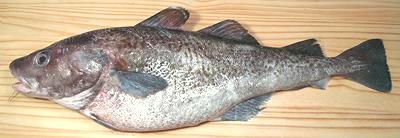 [Arctic Cod, Alaskan Cod, Gray Cod, Gadus macrocephalus]
[Arctic Cod, Alaskan Cod, Gray Cod, Gadus macrocephalus]
This species has a distribution in the North Pacific similar to that of Atlantic Cod in the Atlantic. It is found as far south as the Yellow Sea and the coast of Southern California. This fish can grow to about 4 feet and 50 pounds but the photo specimen, from Canada, was 6.9 pounds and 25 inches long.
This cod is not as threatened as the Atlantic cod, particularly since McDonalds has shifted to Alaskan Pollock (a cod relative) for their fish sticks. The Bering Sea and Aleutian Island fisheries have been certified by the Marine Stewardship Council as responsible and sustainable.
More on Cod, Pollock, Haddock, Hake &
Whiting.
Cod is much preferred for consumer markets such as "fish and chips" because it holds together well in cooking but flakes apart easily on the plate - but most important is its bland flavor and lack of oiliness. This makes it suitable for restaurants where an inoffensive fish is desired.
Some Pacific cod is salted and dried, but not so much as Atlantic cod where there is a large market for dried cod in Spain, Portugal, Italy and Brazil.
Prep & Cleaning: This fish is covered with small very thin scales with medium adherence, and they do not fly around much when scraped off. The fish can contain a huge amount of innards (the bloated appearance of the photo specimen is not caused by a distended swim bladder). The innards are a little difficult to remove in spots simply because of the size of the fish. If you will be using the head you will need to cut the gill arches loose with kitchen shears.
Filleting: This is a fairly easy fish to fillet, not only because of its size but because there are plenty of bones to follow. When you get to the rib cage, just use kitchen shears to cut the ribs from the backbone - they are amazingly short and easily pull from the fillet without taking any flesh. There are, however, for the length of the ribcage, many centerline pin bones as large as the ribs. Pull these out forward with long nose pliers.
Skin: The skin has almost no shrink in cooking, but is usually removed because it's flavor is somewhat stronger than that of the flesh, and the whole point of cod is blandness. This fish skins fairly easily using the long slicing knife and cutting board Method. Before skinning cut away the skirt (belly). It is meaty and useful but needs to be skinned separately due to its width.
Yield: A 6.9 pound cod yielded 2 pounds 14 ounces of skin-on fillet (41%). Skin-off it was about 2 pounds 8 ounces (36%) including the skirt.
Cooking: Cod can be cooked by just about any method used to cook fish. It is quite delicate so needs due care, but that also means it flakes apart very easily on the plate. It is most often lightly battered and fried for "fish and chips".
Stock: Cod heads, bones and fins make a serviceable fish stock, but it is not my favorite (see Method). When simmering the stock foams without mercy and will overflow the pot. Perhaps adding a little oil will supress the foam (cod has almost no oil). Remove any oil that does exist using your gravy separator.
sf_codpacz 100210 - www.clovegarden.com